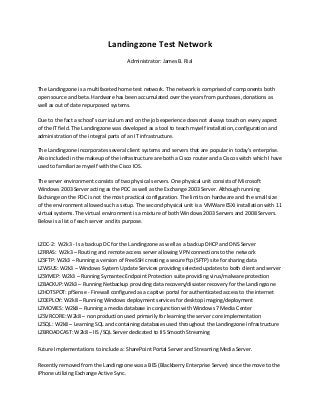
Landingzone Test Network
- 1. Landingzone Test Network Administrator: James B. Rial The Landingzone is a multifaceted home test network. The network is comprised of components both open source and beta. Hardware has been accumulated over the years from purchases, donations as well as out of date repurposed systems. Due to the fact a school’s curriculum and on the job experience does not always touch on every aspect of the IT field. The Landingzone was developed as a tool to teach myself installation, configuration and administration of the integral parts of an IT infrastructure. The Landingzone incorporates several client systems and servers that are popular in today’s enterprise. Also included in the makeup of the infrastructure are both a Cisco router and a Cisco switch which I have used to familiarize myself with the Cisco IOS. The server environment consists of two physical servers. One physical unit consists of Microsoft Windows 2003 Server acting as the PDC as well as the Exchange 2003 Server. Although running Exchange on the PDC is not the most practical configuration. The limits on hardware and the small size of the environment allowed such a setup. The second physical unit is a VMWare ESXi installation with 11 virtual systems. The virtual environment is a mixture of both Windows 2003 Servers and 2008 Servers. Below is a list of each server and its purpose. LZDC-2: W2k3 - Is a backup DC for the Landingzone as well as a backup DHCP and DNS Server LZRRAS: W2k3 – Routing and remote access server allowing VPN connections to the network LZSFTP: W2k3 – Running a version of FreeSSH creating a secure ftp (SFTP) site for sharing data LZWSUS: W2k3 – Windows System Update Services providing selected updates to both client and server LZSYMEP: W2k3 – Running Symantec Endpoint Protection suite providing virus/malware protection LZBACKUP:W2k3 – Running Netbackup providing data recovery/disaster recovery for the Landingzone LZHOTSPOT: pfSense - Firewall configured as a captive portal for authenticated access to the internet LZDEPLOY: W2k8 – Running Windows deployment services for desktop imaging/deployment LZMOVIES: W2k8 – Running a media database in conjunction with Windows 7 Media Center LZSVRCORE: W2k8 – non production used primarily for learning the server core implementation LZSQL: W2k8 – Learning SQL and containing databases used throughout the Landingzone infrastructure LZBROADCAST: W2k8 – IIS /SQL Server dedicated to IIS Smooth Streaming Future Implementations to include a: SharePoint Portal Server and Streaming Media Server. Recently removed from the Landingzone was a BES (Blackberry Enterprise Server) since the move to the iPhone utilizing Exchange Active Sync.
- 2. The Primary server running Windows 2003 Server and Exchange 2003 are configured for both OWA and OMA. This allows access to email via the web and devices utilizing exchange active sync. The infrastructure also includes a NAS unit setup and configuring the open source NAS OS FreeNAS. The configuration includes NFS shares for storage and sharing media. iSCSI targets have also been configured as ESXi storage volumes and Netbackup Storage. The NAS configuration consists of 2 banks configured as RAID Level 5. The system is also setup using dual NICS in conjunction with the Cisco switch for an FEC connection. The performance with this unit is phenomenal including its usage for streaming multimedia. Outside security is provided using Endian Firewall Community Version 2.2. The firewall in configured with both inbound/outbound rules to tighten security on the network. This firewall was replaced over three years ago. The orginal implementation consisted of a SmoothWall which was limited in certain areas of functionality. The idea to move to 2.2 was recent as 2.0 had been running for the last couple of years without any difficulty. This upgrade however has proved to be just as bulletproof in protection, functionality along with a newly developed web interface. Endian Firewall provides me with 4 zones. The RED zone is the global or outside network. The GREEN zone is the LAN side. The BLUE zone on the Landingzone is used to establish connectivity to VOIP service provided by T-Mobile as well as the main WiFi connection utilizing WAP security. The ORANGE zone is experimental and is using the pfSense Firewalls implementation of a captive portal. The captive portal provides a secure proxy allowing users to only connect to the internet if authentication is established. The Landingzone contains many clients running various OS’s. The OS’s on the clients range from Windows XP, Windows 7 to Ubuntu Linux. Two of the clients are running Windows 7 Professional configured solely as Media Center PC’s. My Movies is utilized from the collection management server to the client application configured in the Media Center interface. The Media Center PC’s are configured to auto login and startup Media Center at login. They are both configured to sleep when not in use and awake when the remote is utilized. They both contain the Netflix plug-in as well in order to enhance the Media Center Experience. In conjunction the MCE is connected to a 5.1 Dolby Digital Sound System for a total Home Theater experience. Along with this document is a complete diagram of the Landingzone infrastructure and its components. The only components not listed are the APC Smart-UPS battery backup units providing clean power and outage protection to the network.